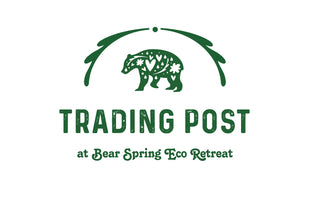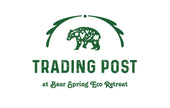From Disaster Management to Community Resilience

We’re starting to feel the cumulative effects of humanity’s impact on the environment. It doesn’t really matter if you believe in climate change or not. It’s impossible to deny that the way we are managing the land is altering our planet in ways that we are having a harder and harder time trying to manage. Plastic waste is filling our oceans, fertilizers are contaminating our drinking water, pesticides are damaging our soils that we rely on to grow the food we eat, and emissions are making the air we breath toxic. Also, “factoring in past weather patterns is becoming harder to do as weather becomes more volatile,” We’re no longer able to predict when drought, heavy rain or even heat waves or cold snaps will hit. Many of our standard environmental practices are based on stable and predictable weather patterns. Our way of life is rapidly destroying them.
The first year we started our glamping business, BC was hit with a heat dome. Not only were temperatures deadly, but the resulting wildfires left us in a blanket of smoke so thick we couldn’t go outside without masks for weeks. The next spring was so cold, we had snow on our opening day in mid-May. The snow is usually gone by the end of March. Then, the past two winters, we experienced such extreme cold temperatures that many of our trees were damaged or died. Now, this summer has been so hot and dry, we’re back to battling wildfires and thick smoke again. Just 50 kilometers north of us, entire villages have had to be evacuated. It’s impossible to conduct business as usual when so many communities surrounding you are affected. Full disclosure, we have an emergency kit packed and ready to go just in case it happens to us, and it could. It’s sitting in the middle of our living room, a daily reminder that we are living in an emergency.
Current logging practices often involve spraying replanted blocks with glyphosate to kill deciduous species, with the belief that reducing competition will support conifer monocrop growth. By “spraying glyphosate-based herbicides across a broad area from the air. The goal is to manage vegetation in a way that promotes the growth of planted seedlings that will one day be logged themselves.” However, recent research is showing that these practices don’t actually help. In fact, quite the opposite is happening. Susan Simmard’s work with herbicides uncovered the fact that denuding tree farms doesn’t help them grow faster — a finding that overturned the forestry industry’s prevailing logic for half a century. And yet, spraying is still standard practice resulting in forests that are much more susceptible to fires than naturally, diverse forests.
“Ultimately, the question comes down to what the forests are valued for — timber resources or biodiverse ecosystems that are resilient to climate change. Aspen trees, for instance, are one of the plants sometimes targeted by these pest management plans. But they are known to be resistant to wildfires and can serve as firebreaks.” Our property has two aspen stands on it. We’ve decided to let these stay in place for this very reason. They provide added protection. In addition to the aspen stands, my family established BC Managed Forest designation in order to maintain the integrity of the forest on our own terms without applying glyphosate, clear cutting or building more roads. This allows us to develop and use management strategies that are appropriate for the size and location of our farm. We are able to protect our water sources and maintain healthy habitat for insects, amphibians and animals. Less than 5% of land in BC is privately owned and, unfortunately, even less is managed in this way.
Most of BC is considered ‘crown land’ and open to the public for recreation and for-profit business operations such as logging, mining and power generation. Companies apply to the government for the right to various parcels of land to exploit for profit. The forest service manages these lands, licenses and the roads built to access them, under the Land Act. “The Land Act governs access and use of public land, which covers 94 per cent of the province, and there are roughly 40,000 active tenures for activities and infrastructure, such as forestry and transmission towers.” Parks are managed separately and make up only about 14% of the land area in BC. These lands are protected. That means that about 80% of BC forests are open to the public for profit.
Current land management practices are becoming more and more unsustainable. We’ve shifted from management to disaster management. Some land has been flooded on purpose, like the Columbia Basin for water storage, while land in other areas has suffered from flooding or slides due to unintended consequences of poor land use. Clearcut logging and the building of roads can all damage forests. As I mentioned earlier, the use of glyphosate (also known as RoundUp) has made our forests dryer and more susceptible to drought. And now, some of our disaster management tools are exacerbating problems further. For example, the use of fire retardants may help mitigate wildfires in the short term but there are long term consequences affecting plants, animals, fish, insects and the quality of our drinking water. Retardants could adversely affect water quality, especially in small ponds and vernal pools where a lack of flowing water would hinder retardant dilution and lead to excessive nutrient production that causes algal blooms and starves water of oxygen. To make matters worse, our health authority relies heavily on the use of chlorine to disinfect drinking water. When chlorine treatment interacts with the chemical properties of algae, harmful byproducts are created. These can also damage our health.
So what can we do to return our land back to a balanced ecosystem? We still need homes to live and buildings to work in. We still need land to grow our food. We still need transportation to get around. We still need clean water to drink. How can we balance our needs with what our land and forests can provide? We can do this “by focusing on what we can actually do and control in our own communities, resilient communities create new ways to support each other as neighbours, live in harmony with our natural environments, and strengthen our local economies. We start where we are, creating a ripple effect.
As we face daunting challenges ranging from wildfires and floods to unaffordable food costs and limited access to healthcare, we can address these by building social connections, a connection to place, and a sense of belonging that many of us yearn for. This in turn builds trust in each other which ultimately results in taking care of each other and the environment in which we live.
When we are connected, we strengthen our ability to respond and adapt because we’re working together. We eliminate the stress of feeling alone. Together, addressing problems at a local level, a stronger community can be built where everyone’s needs are met and everyone belongs and we stop damaging the forests and land that we depend on.
Put down your phone, go out and meet your neighbours, listen to their concerns. Find some common ground. Discuss what actions you can take right now to make a difference. Perhaps it’s carpooling, trading a skill, sharing food or offering a bed to sleep in. Building a strong community is our only way out of this mess. It's hopeful watching how our community has come together to help wildfire evacuees this summer. We can apply these same principles and take every day actions now to prevents more disasters from happening in the future.


Leave a comment